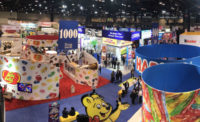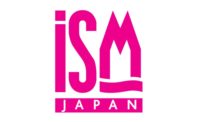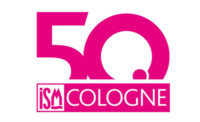![]()
Dichotomies Prevail at Global Sweets Fair
Single-origin chocolate, fruit inclusions, dessert fillings
and wellness offerings are among the many product trends on display at ISM.
Good news, bad news. Bad
news, good news. Good news…well, you get the drift. At the 34th
International Sweets and Biscuits Fair (ISM) in Cologne, Germany, there
seemed to be plenty of dichotomies circulating at the confectionery
industry’s annual global get-together.
For example, there was the good news that China has
opened up its marketplace to confec-tionery imports. Bad news that there
are more Chinese companies entering the global confectionery marketplace,
capitalizing on much lower labor costs.
Good news that the euro’s value has gone up, reinforcing its
position as an international currency. Bad news that the euro’s value has gone
up, making European Union (EU) exports that much more expensive.
Good news that the EU will add 10 more members (70
million people) this year, expanding the continent’s consumer base by
20 percent to 450 million. Bad news that the EU is adding 10 more members,
facilitating trade of confectionery products from those countries, which
have lower labor costs, thus increasing competition.
Good news that manufacturers are continuing to turn out a broad
range of innovative and indulgence confections. Bad news that concern about
obesity has increased interest in regulating the marketing and place-ment of
sweets.
But as unsettling an effect as such dichotomies can have on
planning, the fact that the viewpoints took in both good and bad perspectives
underscored the quiet, albeit cautious, optimism that pervaded the fair.
First, the turnout proved — if not necessarily spectacular —
certainly solid. During the four-day confectionery “Carnival,” 33,500 buyers
from 140 nations sampled, sucked and swallowed a broad range of sweets and treats
from 1,515 exhibitors representing 72 countries.
Varied influences
Second, the fair’s ability to generate excitement and innovation
among manufacturers continued in a grand manner, with large and small companies
contributing to both.
On the chocolate end, the emphasis on dessert-type fillings and inclusions, especially of an Italian origin, was evident. The trend toward single-origin cocoas in chocolate continues, as does a move toward all-natural and/or organic labeling. And alcohol/ cocktail flavors and fillings remain a strong influence in both chocolates and sweets.
On the chocolate end, the emphasis on dessert-type fillings and inclusions, especially of an Italian origin, was evident. The trend toward single-origin cocoas in chocolate continues, as does a move toward all-natural and/or organic labeling. And alcohol/ cocktail flavors and fillings remain a strong influence in both chocolates and sweets.
For many perennial visitors to the fair, this
year’s confectionery confab represented the last year at
Koelnmesse’s “old halls.” The fair is moving to newer
“Eastern Halls” in 2005 as a result of Europe’s radio and
television giant, RTL, which purchased the Rhineside. Manufacturers
who’ve held certain exhibit sites for years will face establishing
new “destination points” for visitors in 2005.
One German manufacturer, however, did make maximum use
of ISM’s existing venue, occupying one of the fair’s largest
spaces. Stollwerck, bolstered by the resources of its new parent, Barry
Callebaut, showcased plenty of its new concepts while occupying the former
exhibit area held for the longest time by Storck.
The company devoted a good portion of the area to highlighting
its Sarotti brand, now designated as Stollwerck’s leading umbrella brand. Sarotti’s
new limited edition Tiamo line, features truffles in three Italian dessert renditions:
Tiramisu, Cappuccino and Cantuccini.
In addition, Stollwerck has added summery notes to its
value line of products under the Alpia name. One of the new Alpia
Summerfresh launches is Schwarze Johannisbeere, a 100-gram bar of white
chocolate featuring fruity pieces of black currants.
Finally, for those more traditional consumers seeking true chocolate taste, Sarotti will launch four new “Origin Chocolate” products.
Finally, for those more traditional consumers seeking true chocolate taste, Sarotti will launch four new “Origin Chocolate” products.
The trend toward single-origin chocolates continues to gather
momentum, with several manufacturers offering their specific interpretations.
Well known Italian chocolate manufacturer ICAM, which unveiled its line of dessert-filled
pralines last year under the Caffe Italiano and Praline Italiano brands, launched
a new line of high-cocoa content, single-origin chocolates under the Extremo
brand.
One company that’s taken note of
consumers’ call for variety is Alfred Ritter GmbH & Co. The
Waldenbuch, Germany-based produce of Ritter Sport chocolate squares has
taken its penchant for geometry to another level, “a third
dimension,” says Jurgen Hermann, marketing director.
Debuted at ISM as the “chocolate cube,”
the square box features 30 individually wrapped 8-gram Ritter Sport minis
in assorted varieties. The box provides consumers with several options, be
it for “self-pampering, sharing” or “giving as
gifts,” the company says.
Of course, when it comes to self-pampering or gift-giving (sharing
could prove difficult), Trubs-chachen, Switzerland-based biscuit manufacturer
Kambly understands exactly what it takes to achieve ultimate indulgence. This
year’s latest creation, the Coeur aux Noisettes or Hazelnut Heart, delivers
three taste sensations in one: a crisp hazelnut biscuit, a virtual melting chocolate
coating, and a “heart” of velvety caramelized nuts.
Supermodel sweets
When it comes to eye appeal, Katjes has never suffered
in drawing a crowd to its television com-mercials, which featured
supermodel Heidi Klum.
The ongoing collaboration takes on increased intensity this year as Katjes launches a new line, “My Favorite Candies by Heidi Klum.” The line will feature two yogurt-based products, Heidi’s Yogurt Fruit Cremes and Heidi’s Yogurt Dessert Cremes as well as classic fruit chews, Heidi’s Fruit Flirtations, which will feature shapes personally designed by Klum. The new Heidi products will debut in April in the United States and be distributed by Hillside, N.J.-based Hillside Candy.
The ongoing collaboration takes on increased intensity this year as Katjes launches a new line, “My Favorite Candies by Heidi Klum.” The line will feature two yogurt-based products, Heidi’s Yogurt Fruit Cremes and Heidi’s Yogurt Dessert Cremes as well as classic fruit chews, Heidi’s Fruit Flirtations, which will feature shapes personally designed by Klum. The new Heidi products will debut in April in the United States and be distributed by Hillside, N.J.-based Hillside Candy.
Katjes, known for its broad line of
“good-for-you” confections has taken that philosophy and added
yet another healthful twist: vegetable flavors in fruit gums.
Gum-muse, a play on the German word Gemuse, which
means vegetables, come in the shapes of vegetables and contain a total of
10 percent natural juice concentrates from the following: tomatoes, carrots
and pumpkins.
In keeping with the Italian dessert theme, wafer and confections
manufacturer Loacker expanded its Qaudratini products, those bite-sized square
renditions of classic Loacker wafers with an Italian Selection of flavors, Amaretto,
Cappuccino and Tiramisu.
Does one sense that there was an Italian theme at the show?
Even Lambertz, the manufacturer of such typically German products as Pfeffernusse
and other gingerbread specialties such as Mozartkugel, came out with an Italian–sounding
product line of filled biscuits dubbed Lamber Tissimo.
Conscious of the wellness demands by consumers, the company
has also launched a new line dubbed Sensations. The 175-gram bags, available
in mint or latte macchiato flavors, contain chocolates filled with rice crisps
and biscuits.
Wellness, of course, doesn’t just extend toward
one’s physical state of being. It also encompasses a state of mind,
one that can be triggered by flavors and aromas.
Take Ragold’s new caipirinha-flavored granini candy. By capitalizing
on the recent popularity of Brazil’s national cocktail, one that combines brown
cane sugar alcohol with limes, the company introduced its granini Caipirinha,
a hard candy that combines freshly squeezed limes and brown cane sugar flavors
punctunated with a fruity filling.
The company also added two new summer products, granini Schorle
Apple and granini Schorle Black Currant. The fruit candies feature an innovative
surprise for consumers, a “fizzy” and fruity sherbet center that delivers texture
and taste.
Of course, there were countless other offerings at the fair,
ranging from the unusual to the usual. But that’s another dichotomy for another
time.





